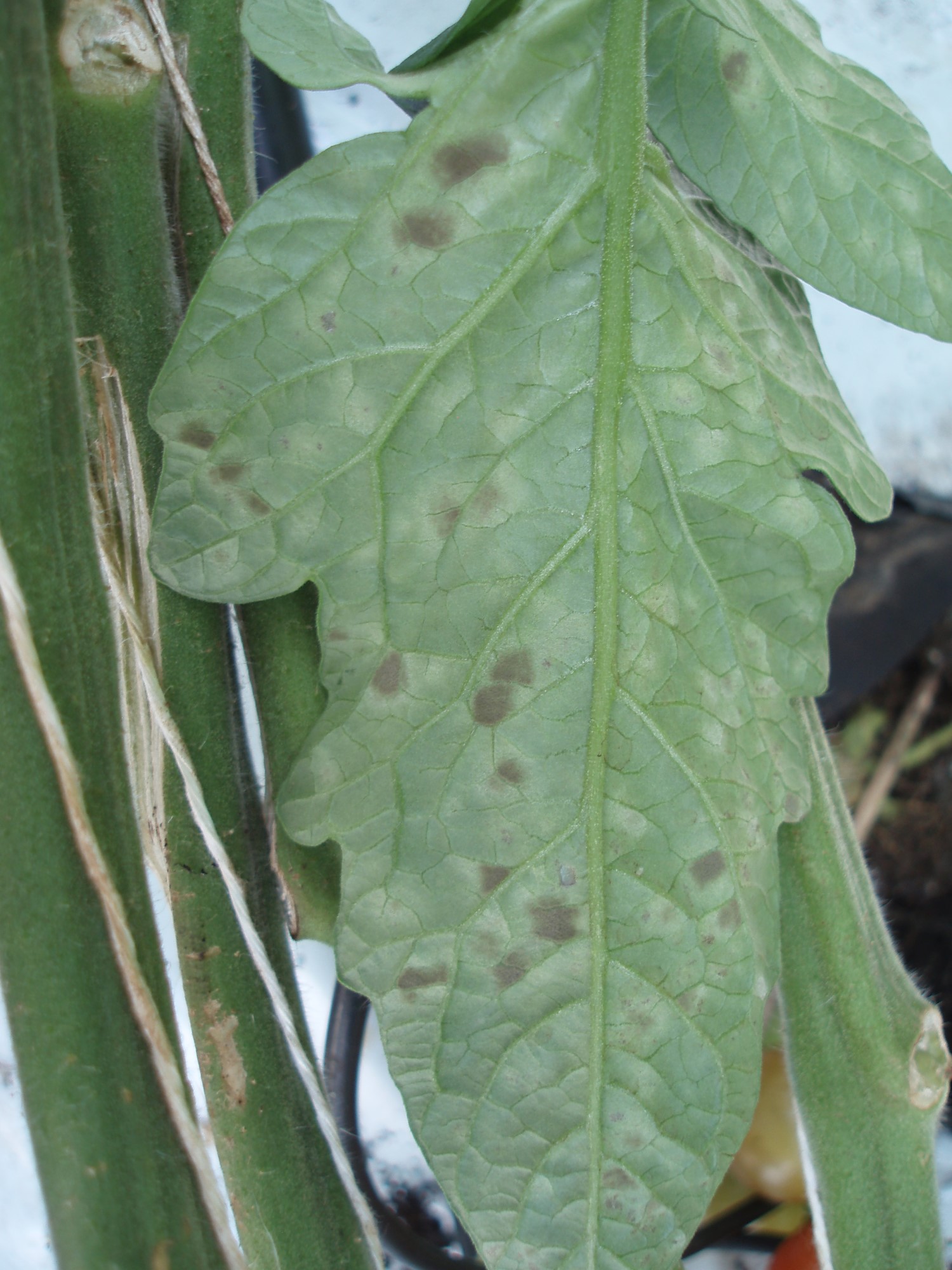Please click here to access the main AHDB website and other sectors.
- Home
- Knowledge library
- Cause, symptoms and spread of tomato leaf mould
Cause, symptoms and spread of tomato leaf mould
Tomato leaf mould (Passalora fulva) is one of the most destructive foliar diseases affecting tomatoes grown in humid conditions. Read about the cause, symptoms and spread of this disease.
Back to: Tomato leaf mould best practice
Cause
Tomato leaf mould, caused by Passalora fulva (previously known as Cladosporium fulvum), is a destructive foliar disease of increasing importance in the UK.
Outbreaks have occurred most years since 2000 and affected a range of varieties. Although the disease was previously well controlled by genetic resistance, the cultivation of varieties without claimed resistance and the emergence of strains capable of overcoming resistance genes deployed in current varieties seem to cause the new outbreaks.
Identification
There is no easy method available to identify strains, apart from the classical approach of determining pathogenicity, one isolate at a time, which is time-consuming and costly. The fungus has been found both on and within the seed coat, and seedborne infection has been reported.
Infected seed planted in sterile compost has been shown to develop P. fulva symptoms on cotyledons. This indicates the disease can be present from sowing and this should be considered when developing treatment strategies.
P. fulva produces only one spore type: the conidium. These spores are produced in vast numbers and are easily spread on air currents, insects and via hands and clothing. They are highly resistant to dry conditions and low temperatures. It is believed that spores survive in a dormant state on surfaces from one crop to the next.
Although the pathogen can only grow on living tissue, it can also survive for long periods on dried leaf debris. This makes complete disinfestation challenging.
Environmental factors and symptoms
Environmental conditions strongly influence P. fulva infection and severity. High humidities are very favourable, with relative humidities (RH) above 85% critical to allowing spores to germinate and fungal hyphae to penetrate the stomata. Warm temperatures of 22–24°C, combined with high humidities, can lead to P. fulva epidemics.
At temperatures of 12°C or lower, the disease will not usually be an issue, but it is still able to grow at temperatures as low as 4°C. In these cool conditions, disease development is so slow that infected foliage is normally removed before the disease can establish.
Disease development and symptoms
 ADAS.jpg)
Figure 1. Life cycle of Passalora fulva. Copyright ADAS. Click here to see a larger version of this image.
Leaf mould may appear in April or May but usually first in June or July.
Seven days after infection, diffuse, yellowish spots appear on the upper leaf surface (Figure 1), with advanced stages showing aggregations of velvety fungal hyphae exiting from stomata on the lower leaf surface and releasing large numbers of spores, appearing as a brown mould (Figures 2 and 3).

Figure 2. Yellow spots with indefinite border on the upper surface of tomato leaves. Copyright Dave Kaye, RSK ADAS

Figure 3. Velvety-brown fungal growth on the underside of tomato leaves. Copyright Dave Kaye, RSK ADAS
Affected leaves wilt, wither and die but generally do not drop off (Figure 4) because the stomata are blocked by the fungus and unable to close. The lower leaves are generally attacked first, but on rare occasions in an epidemic the upper leaves are also affected. In severe cases, virtually all plants in a row might be affected and the crop appears as if it has suffered severe scorch of lower leaves.

Figure 4. Affected leaves shrivel but remain on the plant. Copyright Dave Kaye, RSK ADAS
Attack on the stem, flower, calyx and fruit from the infection can occur in severe cases but is much less common than on the leaves. Fruit symptoms are black, irregularly shaped lesions with a diffuse edge on green or mature fruit.
Crop yield is reduced significantly when more than 50% of the leaf area is covered by lesions and so early outbreaks are more likely to affect yield.
Mutation
No sexual stage of P. fulva has been observed. Although asexual, the fungus mutates rapidly and has a short life cycle.
This has led to the development of several new races able to overcome existing resistance genes. Several races have been described, with many resistance genes identified.
Useful links
Download a PDF version of the Tomato Leaf Mould Best Practice Guide
Go to Tomato leaf mould: Control options
Go to Tomato leaf mould: Chemical control
Go to Spray application for controlling tomato leaf mould
Go to Crop husbandry to help control tomato leaf mould
Go to Tomato leaf mould: Resistant varieties
If you would like to order a hard copy of the Tomato leaf mould best practice guide, please contact:
Email: publications@ahdb.org.uk
Telephone: 0247 799 0069
Tomato leaf mould web pages originally authored by Sarah Maybe and Dave Kaye (RSK ADAS).
Topics:
Sectors:
Tags:

